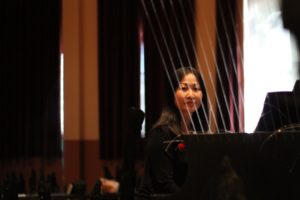 The artist Shawn Skabelund was in Ashurst Hall on a recent Saturday afternoon, surveying what has surely never been seen before in the oldest building on the Northern Arizona University campus: a dwarf forest of charred logs ranging from head-high to stubs no taller than a monsoon mushroom. There were many hundreds of them, perhaps a few thousand—Skabelund said he’d lost count. For now they were arrayed at random in the corners of the hall. But the artist, who creates much of his work from materials culled from nature, was planning to spend much of the next week arranging them to fit the vision in his head, which meant they would end up in an ordered circular pattern around the piano at the room’s center.
The artist Shawn Skabelund was in Ashurst Hall on a recent Saturday afternoon, surveying what has surely never been seen before in the oldest building on the Northern Arizona University campus: a dwarf forest of charred logs ranging from head-high to stubs no taller than a monsoon mushroom. There were many hundreds of them, perhaps a few thousand—Skabelund said he’d lost count. For now they were arrayed at random in the corners of the hall. But the artist, who creates much of his work from materials culled from nature, was planning to spend much of the next week arranging them to fit the vision in his head, which meant they would end up in an ordered circular pattern around the piano at the room’s center.
It had taken Skabelund and a small team of helpers more than five hours to move the logs from the family’s garage to campus, using two minivans and a couple of borrowed pickup trucks. One of the vans belonged to the pianist Janice Chen-Ju Chiang, who teaches at NAU and who, in 2013, when she went to see Skabelund’s installation piece Virga: The Hunt for Water at the Coconino Center for the Arts, suggested that the two of them create a piece together.
“I wanted to play a concert where the people weren’t just sitting in chairs,” Chiang says. So, the two came up with the idea of converting the august hall into a forest—albeit a burned one. In it, on a series of evenings from Sept. 22 through 28, the pianist will play what she calls “Composition for Forests” while a small audience mills around on pathways through the charred logs. The music comprises eight pieces by composers on five continents. Like Skabelund’s sculptural installation, it is an extended riff on the pair’s perception that our connection with nature, these days, is inextricably tied up with death, whether in the form of catastrophic wildfire or climate change.
Skabelund recycled some of the smaller charred fragments from Virga. But he spent much of the summer harvesting the larger logs, often with the help of a couple of interns and of son Adrian and daughter Chiara Rose—all using the family minivan. They came from incompletely burned slash piles out in the ponderosa pine. Skabelund brought them to the garage and worked with them so that they met his two requirements: they had to stand vertically, and they had to be perfectly black. That called for a lot of time applying wood stain.
“They don’t always burn that completely in the piles,” Skabelund says, “so I used Espresso wood stain to give a warm glow.”
But in every other regard the logs were free to express themselves, and even before they were organized roughly by height, as Skabelund was planning, it was easy to see their sculptural appeal. Each log had its own swooping lines, its variegated patterns of glossy smooth heartwood and half-curled bark. Some had intricate traceries of beetle-chewed galleries; some were earthy, bottom-heavy; in others the flames had carved away so much wood that they seemed to swoop upward like a Brancusi sculpture. They were clearly individuals—or perhaps it would be most accurate to write that it was the fire that had made them individuals, shaping each into a unique form never seen before.
By mid-afternoon, after about 20 loads, the family garage was open for regular use again, though it did contain a couple of charred logs about 10 feet long that Skabelund had harvested from the Schultz Fire area—the germs of a piece to come later. Up in Ashurst the logs stood like silent onlookers in the corners, while the humans who had carried them had unique patterns of charcoal marks on arms, shirt and face.
Skabelund pointed out a black metal form that had been placed all around the grand piano, fabricated to his specifications at Mayorga’s Welding. He was trying to figure out exactly how to attach multiple lengths of 130-pound-test fishing line from holes drilled high in the steel to a wire grid in the ceiling, 30 feet up. The filament would form a diaphanous cone growing upward from the piano, and it provided a place where he could attach five taxidermied crows that were part of the piece.
On the floor, lengths of blue masking tape marked out the pattern of logs and walkways. Skabelund looked down. He was thinking about the many hours to come in arranging the logs, and wondering if he really had enough of them.
“You know, when Chiara and I came in here the other day to start work we finally noticed that the piano hadn’t been placed exactly in the middle of the room,” Skabelund says. “It was 8 inches off. We had to re-do all the blue tape. No one else would have noticed it, but I want this to be perfect.”

